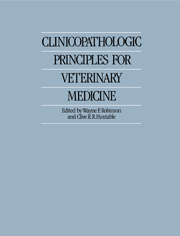Book contents
- Frontmatter
- Contents
- Contributors
- Preface
- Acknowledgements
- 1 The relationship between pathology and medicine
- 2 The immune system
- 3 The hematopoietic system
- 4 Acid–base balance
- 5 The respiratory system
- 6 The cardiovascular system
- 7 The alimentary tract
- 8 The liver and exocrine pancreas
- 9 The urinary system
- 10 The endocrine glands
- 11 The skin
- 12 The skeletal system
- 13 The nervous system
- 14 Muscle
- 15 Metabolic disease
- 16 The reproductive system
- Index
2 - The immune system
Published online by Cambridge University Press: 19 January 2010
- Frontmatter
- Contents
- Contributors
- Preface
- Acknowledgements
- 1 The relationship between pathology and medicine
- 2 The immune system
- 3 The hematopoietic system
- 4 Acid–base balance
- 5 The respiratory system
- 6 The cardiovascular system
- 7 The alimentary tract
- 8 The liver and exocrine pancreas
- 9 The urinary system
- 10 The endocrine glands
- 11 The skin
- 12 The skeletal system
- 13 The nervous system
- 14 Muscle
- 15 Metabolic disease
- 16 The reproductive system
- Index
Summary
Knowledge of immunology has now become essential for the comprehension of many disease processes. In addition to the awareness of an expanding spectrum of diseases which have at their core immunologic mechanisms, basic information is also required on the cells of the immune system and their interactions and effector mechanisms.
The immune system is extremely complex, performing a variety of activities directed towards maintaining homeostasis. It consists of an intricate communications network of interacting cells, receptors and soluble factors. As a consequence of this complex organization, it is immensely flexible and is able greatly to amplify or markedly to diminish a given response, depending upon the circumstances and momentary needs of the animal. A normally functioning immune system is an effective defense against the intrusion of noxious foreign materials such as pathogenic microbial agents, toxic macromolecules and to some extent against endogenous cells which have undergone neoplastic transformation. However, by virtue of its inherent complexity, the system has the potential to malfunction and, since it also has the ability to trigger effector pathways leading to inflammation and cell destruction, may then cause pathologic effects ranging from localized and mild to generalized and life threatening.
The intensity of a particular immune response depends on many factors, including genetic constitution, and hormonal and external environmental influences. Amongst these, it is now becoming clear that genetic background plays a highly influential role, and to a significant extent, therefore, immunopathologic events are a reflection of genetically determined aberrations in immune regulation.
- Type
- Chapter
- Information
- Clinicopathologic Principles for Veterinary Medicine , pp. 4 - 37Publisher: Cambridge University PressPrint publication year: 1988



